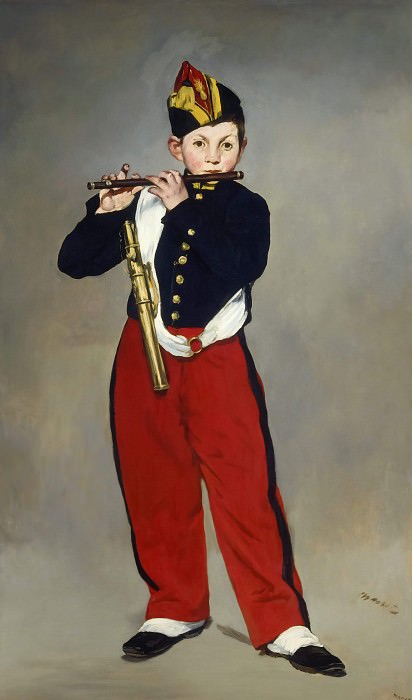The Fifer Édouard Manet (1832-1883)
Édouard Manet – The Fifer
Edit attribution
Download full size: 2350×4000 px (0,6 Mb)
Painter: Édouard Manet
Location: Orsay Museum (Musée d’Orsay), Paris.
The painting was painted in 1866. It is the artist’s great creation. Poetry and austerity are combined here into one inseparable whole. We see an ordinary little boy. He is a child with a peculiar immediacy and deliberate importance. He is dressed in red pantaloons and a blue uniform. In the clothes creates a sharp contrast of two colors. Manet was very interested in the details of various costumes, which is why in many of his paintings appear the characters in various unusual clothing.
Description of Eduard Manet’s painting The Flutist
The painting was painted in 1866. It is the artist’s great creation. Poetry and austerity are combined here into one inseparable whole. We see an ordinary little boy. He is a child with a peculiar immediacy and deliberate importance. He is dressed in red pantaloons and a blue uniform.
In the clothes creates a sharp contrast of two colors. Manet was very interested in the details of various costumes, which is why in many of his paintings appear the characters in various unusual clothing. The artist himself also liked to change clothes. How charming this child is. Manet’s painting is incredibly maximally charming. The colors are so simple that an incredible harmony is created. The boy’s figure looks incredibly simple. The environment surrounding the hero of the painting is very mysterious. The background is almost monochromatic, and there is absolutely no sense of the horizon line. The background just evaporates, and the boy’s figure is surrounded by an invisible shroud. The whole atmosphere is created from something beyond the reach of ordinary reality, but this is where true painting and its incredible poetry is born. Manet painted in the style of Japanese prints. Their specificity precisely consisted in the fact that the figures had a very clear silhouette, and all the surroundings are only slightly marked and could only be guessed at. The background of this work is absolutely flat, and the details of a secondary character are unimportant here. The Salon of 1866 categorically rejected this work of the artist, considering that it lacks the much needed volume and air, as well as a complete lack of perspective. Critics called the flute boy a jack-of-all-trades, as if pinned to a faintly discernible wall. The artist portrayed a very real flutist from the orchestra who posed for him on purpose. It is believed that Manet painted the boy’s face from his son.
Кому понравилось
Пожалуйста, подождите
На эту операцию может потребоваться несколько секунд.
Информация появится в новом окне,
если открытие новых окон не запрещено в настройках вашего браузера.
You need to login
Для работы с коллекциями – пожалуйста, войдите в аккаунт (open in new window).




















COMMENTS: 1 Ответы
Вероятно, здесь изображён сын Мане. Работа создана под большим впечатлением от картины Диего Веласкеса “Портрет Пабло де Вальядолида”.
You cannot comment Why?
This painting, The Fifer, by Édouard Manet, depicts a young boy standing and playing the flute. He is dressed in a military uniform consisting of a dark blue jacket with gold buttons, bright red trousers, and a distinctive kepi cap adorned with red, yellow, and black. A white sash is wrapped around his waist, and a golden-colored instrument, possibly a bugle or a telescoped object, hangs diagonally from his left shoulder. The background is a muted, neutral gray, which serves to highlight the vibrant colors and the central figure of the boy. His expression is direct and serious, with rosy cheeks, and his hands are gracefully positioned on the flute.
The subtexts of this painting can be interpreted in several ways: